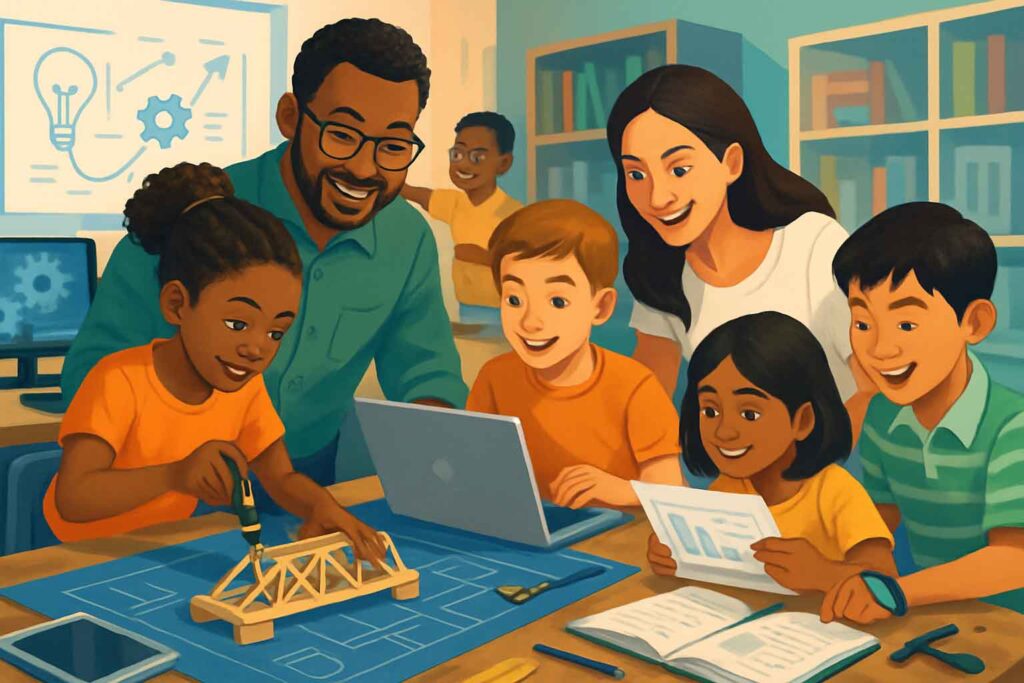Introduction
Traditional education has often focused on the memorization of facts and figures. However, in a rapidly evolving world that demands creativity, critical thinking, and collaboration, a more dynamic approach is needed. Enter Project-Based Learning (PBL), an instructional methodology that empowers students to gain knowledge and skills by working for an extended period to investigate and respond to an authentic, engaging, and complex question, problem, or challenge. This article will explore the transformative power of PBL, its core components, its profound benefits for children, and how parents and teachers can effectively implement this approach to foster deep, meaningful learning.
What is Project-Based Learning?
Project-Based Learning is a student-centered pedagogy where learning is driven by a real-world problem or challenge. Unlike traditional projects that often serve as a culminating activity, in PBL, the project is the learning. Key characteristics of PBL include:
•Driving Question or Problem: Learning is anchored in a meaningful, open-ended question that students must investigate and answer.
•Sustained Inquiry: Students engage in a rigorous, extended process of asking questions, finding resources, and applying information.
•Authenticity: The project has a real-world context, tasks, and tools, and addresses a topic of significance to the students.
•Student Voice and Choice: Students have a say in the project’s direction, the resources they use, and the final product they create.
•Reflection: Students and teachers reflect on the learning process, the effectiveness of their inquiry and project activities, and the quality of their work.
•Critique and Revision: Students give, receive, and use feedback to improve their process and products.
•Public Product: Students make their project work public by explaining, displaying, and/or presenting it to people beyond the classroom.
The Benefits of Project-Based Learning
PBL offers a wealth of benefits that extend far beyond academic knowledge:
1. Deeper Learning and Retention
By actively engaging with a topic over an extended period, students develop a deeper understanding of concepts and are more likely to retain what they have learned. PBL connects learning to real-world applications, making it more relevant and memorable.
2. Development of 21st-Century Skills
PBL is an ideal framework for cultivating essential skills for the modern world:
•Critical Thinking and Problem-Solving: Students analyze complex problems, gather and evaluate evidence, and develop solutions.
•Collaboration: Working in teams, students learn to communicate effectively, share responsibilities, and negotiate roles.
•Creativity and Innovation: PBL encourages students to think outside the box and develop original ideas and products.
•Communication: Students practice both written and oral communication skills as they research, collaborate, and present their findings.
•Self-Management: Students learn to manage their time, set goals, and take responsibility for their learning.
3. Increased Engagement and Motivation
The authentic and student-driven nature of PBL makes learning more engaging and motivating. When students have a voice and choice in their learning, they are more invested in the process and outcome.
4. Fostering a Growth Mindset
PBL encourages students to embrace challenges, persist through setbacks, and view mistakes as learning opportunities. This fosters a growth mindset, the belief that abilities can be developed through effort and dedication.
5. Connection to Community
Many PBL projects involve collaboration with community members, experts, or organizations. This provides students with authentic audiences for their work and helps them see the real-world impact of their learning.
Implementing Project-Based Learning
Here’s how parents and teachers can bring PBL into their learning environments:
For Parents:
•Encourage Passion Projects: Help your child identify a topic they are passionate about and guide them in developing a project around it. This could be anything from building a website about their favorite animal to starting a small community garden.
•Be a Facilitator, Not an Expert: You don’t need to have all the answers. Your role is to ask guiding questions, help your child find resources, and support them in their inquiry process.
•Connect with the Community: Help your child find experts or mentors in the community who can provide guidance and feedback on their project.
•Celebrate the Process: Focus on the learning journey, the skills developed, and the effort invested, not just the final product.
For Teachers:
•Start with a Driving Question: Design a compelling, open-ended question that will spark curiosity and guide student inquiry.
•Scaffold the Process: Break down the project into manageable steps and provide clear expectations and deadlines.
•Provide Resources and Support: Offer a variety of resources (books, websites, experts) and provide guidance and feedback throughout the project.
•Foster Collaboration: Create opportunities for students to work in teams and learn from each other.
•Assess Both Process and Product: Use a variety of assessment methods, including rubrics, self-assessments, and peer feedback, to evaluate both the final product and the skills developed during the process.
•Plan for a Public Showcase: Arrange for students to present their work to an authentic audience, such as parents, community members, or other classes.
Conclusion
Project-Based Learning is a powerful approach that transforms education from a passive experience to an active, engaging, and empowering journey. By placing students at the center of their learning and connecting it to the real world, PBL not only deepens academic understanding but also cultivates the essential skills and mindset needed to thrive in the 21st century. Let’s empower our children to move from idea to impact, one project at a time.
